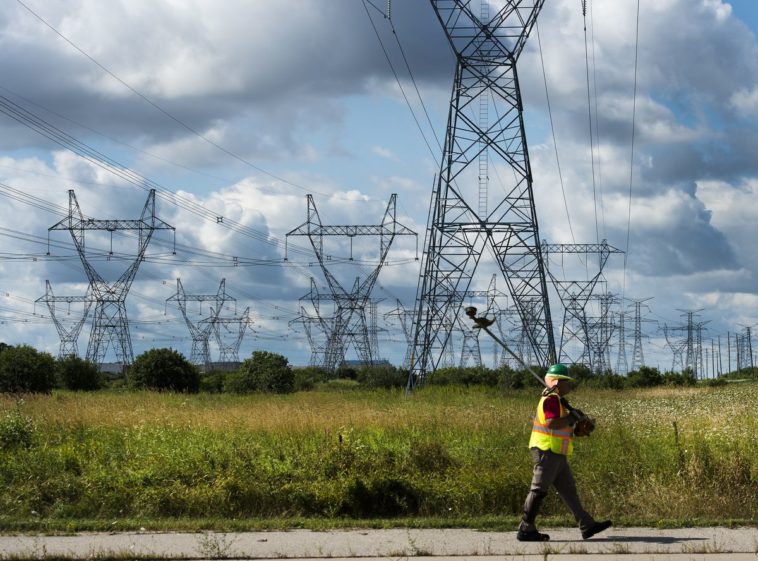Climate goals are dependent on hydro collaboration
/cloudfront-us-east-1.images.arcpublishing.com/tgam/WQS25YDCCRLLTJLYBNUQYKM4PM.jpg)
A worker walks past rows of power lines with his weed whacker in Mississauga, Ont., Aug. 19, 2019.
Nathan Denette/The Canadian Press
Patrick Bateman is the interim president of WaterPower Canada, a national not-for-profit trade association.
On April 22 and 23, the United States will formally return to the helm of the global climate-change conversation when U.S. President Joe Biden hosts a world Leaders Summit on Climate. Invitees include the heads of state from the 17 countries responsible for 80 per cent of global greenhouse gas emissions and of global gross domestic product.
Mr. Biden and Prime Minister Justin Trudeau are expected to use the occasion to announce new, more ambitious national emissions-reduction targets that both federal governments would work to achieve by 2030. The regulations and the investments that will inevitably follow will put the long-time allies and trading partners on an accelerated pathway to a cleaner energy future.
For a hint of what this future could entail, we can look to the renewed bilateral partnership that both leaders affirmed after their recent meeting. The document included commitments to increase clean-electricity production; Mr. Biden set a target of 100-per-cent clean power by 2035, while Mr. Trudeau pledged to reach 90 per cent by 2030.
Both leaders also agreed to encourage new infrastructure that would help further integrate our electric grids and facilitate even more electricity trade across the border. On this front, we have a strong foundation already in place. Transmission lines already connect every Canadian province with at least one U.S. state.
By strengthening and expanding connections, neighbouring regions can typically gain multiple advantages, including improved resilience and reliability during periods of high demand or extreme-weather events, and greater affordability. Specifically, Canada’s electric grid offers several advantages to the U.S. because 60 per cent of our annual electricity production is from hydropower.
Let’s start with the bottom line. Importing Canadian electricity offers a clear economic benefit to our southern neighbour. For example, the United States International Trade Commission recently concluded that owing to Canadian hydropower, Massachusetts can meet its new long-term renewable and clean-energy commitments with relatively modest increases in retail electricity rates. Canadian electricity imports can, the commission said, “help stabilize electricity prices, reduce costs to consumers, and make variable renewable energy (such as wind and solar) more profitable.”
Canada’s hydropower-generation capacity also offers the U.S. two things it will need as it works to decarbonize its grids: flexibility and rock-solid dependability.
First, consumer electricity demand constantly fluctuates. Similarly, the output from renewable energy resources such as wind and solar varies according to weather conditions. By adjusting the quantity of water flowing into hydropower turbines, producers can rapidly ramp up or down as needed to flexibly balance supply with demand.
Then there’s dependability. The vast quantities of water stored in Canada’s reservoirs – or flowing in waterways – represents this country’s largest source of energy storage. Generators currently store water to meet peak demand; some reservoirs can even store water from one year to the next. With improved cross-border links, Americans can access this enormous liquid battery in moments and in a crisis.
It’s the same deal on our side of the border. Historically, the proximity of Canada’s electricity generation to American population centres has meant that our grids are better integrated north-south than east-west.
Now, the phaseout of coal-fired electricity has created the impetus for greater regional collaboration within Canada. For example, the “Atlantic Loop,” an energy project that would supply electricity from Quebec and Newfoundland and Labrador, to New Brunswick and Nova Scotia, demonstrates how regional collaboration provides efficient ways to achieve our climate goals. That potential to collaborate is present throughout the country.
As utilities and industries across Canada and the U.S. grapple with future climate-driven risks while simultaneously reorienting for a cleaner-energy future, flexible and dependable hydropower – facilitated by improved cross-border transmission infrastructure – will serve as the backbone for our continental clean-energy ambitions for decades to come.
In all reality, the likelihood of Canada and the U.S. reaching our clean-electricity targets is dependent upon strengthened transmission capacity between the regions with abundant hydropower capacity, and those without.
Your time is valuable. Have the Top Business Headlines newsletter conveniently delivered to your inbox in the morning or evening. Sign up today.
Published at Tue, 30 Mar 2021 23:42:58 +0000





Comments
Loading…